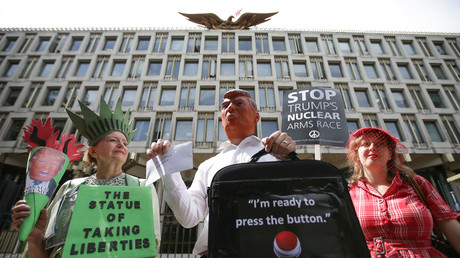What’s INF & why does it matter? Trump wants to kill pivotal nuclear treaty that calmed the Cold War
Boldly accusing Russia of violating the Intermediate-Range Nuclear Forces treaty, Donald Trump has vowed to pull out of the “unacceptable” deal. Moscow however has its own view on who is in violation of the key Cold War era pact.
What is INF & why it matters?
The INF treaty signed in 1987 between the USSR and the United States eliminated nuclear and conventional ground-launched ballistic and cruise missiles with ranges of 500 to 5,500 kilometers. The historic accord marked the first time the superpowers had agreed to eliminate an entire category of nuclear arms and introduce on-site inspections for verification. The deal brought much-needed detente to an atmosphere of tense Cold War stand-off, and allowed Europe, which housed much of the American arsenal, to breathe a sigh of relief.
INF shortcomings
The deal didn’t affect aircraft- and sea-based missiles, an area where the US had a clear strategic advantage at the time, so it was widely seen as a gesture of good will by the USSR at a cost to its own national security. Another significant problem with the INF treaty was that other nuclear-armed nations were never party to it – including US allies France and the UK, as well as China.
US claims & accusations
Despite Moscow’s compliance with the deal, Washington – citing its classified intelligence – keeps claiming that Russia has been secretly developing intermediate-range missiles, in particular those that can allegedly be fired from the tactical missile system Iskander-M, deployed along the country’s western borders.
READ MORE: US accuses Russia of non-compliance while funding mid-range missile R&D
Moscow’s concerns with Washington’s ‘interpretation’ of INF
Russia has its own, rather clearly-defined issues with how the US interprets the treaty:
- Moscow is accusing the US of violating the treaty by placing standardized ground-based Aegis Ashore anti-missile launchers in Europe that can potentially be used to fire cruise missiles.
- It has also pointed to a series of so-called ballistic target-missiles, such as Hera, that are used in the US in anti-missile system tests, as being in violation.
- Russia is also concerned at heavy combat drones, a staple of American air power that can perform tasks of ground-launched cruise missiles, in violation of the INF treaty.
US plans & excuses
The White House administration, which is pursuing a quite aggressive nuclear arsenal modernization strategy, has already authorized plans to develop what it initially called an ‘INF-compliant’ medium-range missile as outlined in the Trump Nuclear Posture Review, and now seems to look for excuses to pull out of the cornerstone nuclear arms agreement.
READ MORE: US defense bill authorizes development of ‘INF treaty-compliant’ mid-range missile
Claiming the move is crucial to counter the alleged growing threat from both Russia and China, US President Donald Trump stressed the situation was “unacceptable” and that the US will “have to develop those weapons.” Announcing his intention to scrap the INF commitments, Trump boasted:
“So we have a tremendous amount of money to play with our military.”
Russia’s position
Russia has vowed to observe the INF treaty as long as the US does. However, should Washington choose to pull out like it did from the ABM deal, President Vladimir Putin said:
“Russia’s response would be immediate and mirror-like.”
Subscribe to RT newsletter to get stories the mainstream media won’t tell you.






Comments are closed.